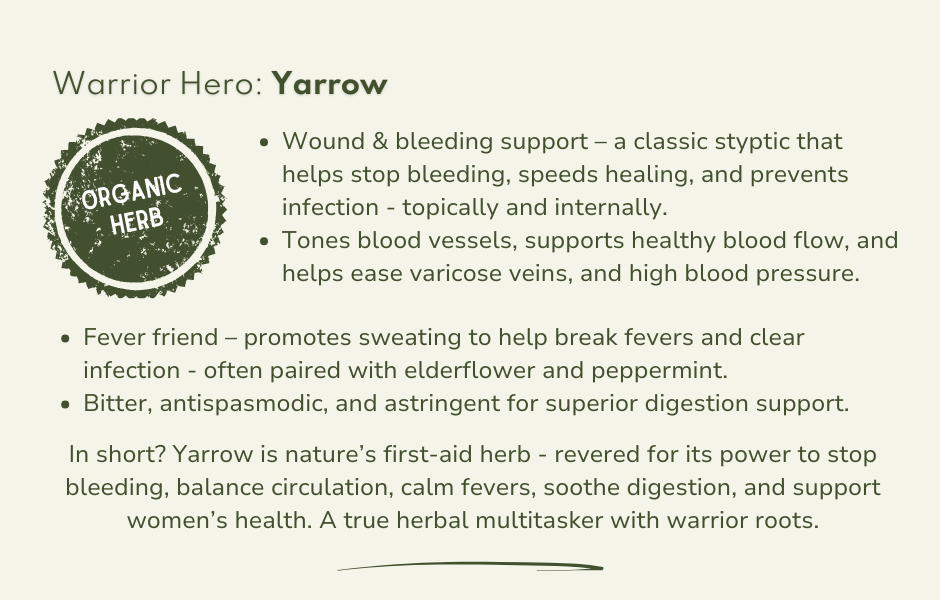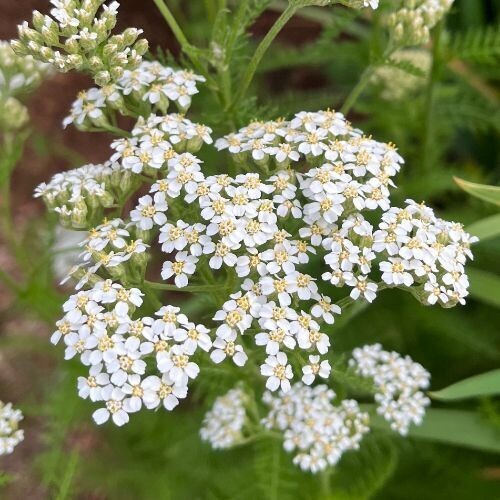YARROW (Achillea millefolium) *Organic herb for horses
Yarrow Herb for Horses
Yarrow is one of the most versatile botanicals we have - a wild-growing powerhouse known for its ancient wound-healing legacy, circulatory wisdom, and remarkable affinity with female reproductive and urinary systems.
Whether sipped as a tea, applied as a poultice, or fed freshly picked, yarrow is a staple in every herbalist’s kit and field-first-aid cupboard.
Please note this is a nutritional, functional horse food supplement and not veterinary medicine. See Dr Kellon's Horse Sense - Nutrition is not 'Alternative' Therapy .

Find Yarrow in the EquiNatural range
We blend yarrow into many of our supplements including BreathePlus , GutBitters , MellowMare , and PollenTonic .
Composition & Feed Guide
💧Organic Yarrow Herb Tincture
Our human-grade, certified organic tinctures give you a ready-to-absorb potent source of phytonutrients at the highest-strength available, for immediate absorption straight into the bloodstream and to the body’s cells.
- Achillea millefolium (Yarrow)
- Flowering tops
- Distilled/Infused 1:3 35%
- Organic Grown
~ Feed Guide - yarrow tincture for horses
- 6ml/100kg bodyweight, daily in feed.
- Our tinctures come in a heat-sealed, twin-neck, child-resistant HDPE plastic dosing bottle, complete with dosing chamber. ♻️ HDPE is recyclable and low-impact - aligned with our sustainability ethos.
🌿Organic Dried Yarrow Herb
Grown, harvested and dried without the use of agri-chemicals, non-irradiated and GMO free - see our Quality page for Quality Management & Certification Documents.
- Achillea millefolium (Yarrow) , Organic Cultivated *, Origin UK
- Flowering Tops
- Organic Cultivated*
- Origin UK
* Grown especially for us organically and biodynamically by Organic Herb Trading Co. https://www.biodynamics.com/what-is-biodynamics
~ Feed Guide - dried yarrow herb for horses
- 5g/100kg bodyweight per day, i.e. 25g for a 500kg horse.
- Want a scoop? You can add a scoop to your basket during checkout.
- ♻️Supplied in a 100% fully recylable, resealable, food-grade foil pouch for freshness.
Functional Nutritional Value
Constituents: Volatile oil (e.g., α- and β-pinene, borneol, bornyl acetate, camphor, alpha-caryophyllene, 1,8 cineole [Hoffmann, 2003], thujone [Wood, 2009]), sesquiterpene lactones (e.g., achillicin, achillifolin, achillin, millifin, millifolide), flavonoids (e.g., apigenin, isorhamnetin, luteolin, rutin), tannins, phenolic acids (e.g., caffeic acid, salicylic acid), alkaloids (e.g., achiceine, achillein, moschatine, stachydrine, trigonelline), coumarins (Hoffmann, 2003), achilleic acid (aconitic acid), potassium, and calcium salts, vitamin C, bitters, and sterols.
Footnotes
- Laboratory tested for identification and compliance to the British and European Pharmacopoeia standards.
- Human grade.
- Please be aware that if you're purchasing our dried botanicals for human use, our dried range is cut to appropriate sizes for feeding to horses.
- ♻️ Eco Note: Our packaging is recyclable and refillable.
- 🧊 Storage Tip: Keep cool and dry.
Clinical Considerations
- Yarrow is not recommended during pregnancy due to its emmenagogue action.
- Its safety has not been established for use during nursing.
Yarrow in History & Tradition
It’s always difficult to know where to start with yarrow, for the simple reason that it’s so useful for so many different issues. Yarrow really requires an entire book for itself!
Yes it’s a common weed that grows freely in grassland, chalk land, roadsides – go on any walk or ramble and you’ll likely see yarrow. And yet it’s an incredible healing herb. Otherwise known as Achillea millefolium , it's not only antimicrobial, relieves pain and stops bleeding, but it’s most famous and most ancient use is as a wound healer.
Yarrow’s legacy reaches deep into human history - so much so that pollen from Achillea was found in a Neanderthal grave in Iraq, dated at 50,000 years old. This suggests we’ve had a relationship with this plant longer than recorded civilisation itself.
In classical mythology, Achillea takes its name from Achilles, the Greek warrior said to have been bathed in yarrow tea as an infant by his mother to confer protection - all but the heel she held him by. On the battlefield, Achilles reputedly used yarrow to treat the wounds of his fellow soldiers. This lore birthed its many folk names: woundwort , soldier’s woundwort , staunch weed , nosebleed plant , carpenter’s herb.
Historical references to yarrow can be found in the works of Dioscorides and Pliny the Elder, who recommended it for ulcers, dysentery, earaches, toothaches, and excessive bleeding. During the American Civil War, yarrow was still being used in battlefield medicine to dress wounds, stop bleeding, and prevent infection.
It was also a staple in medieval herbals for its ability to staunch blood, tone tissues, and regulate fevers. In folk practice, it was considered a ‘blood mover and equaliser’ - helping where blood was stagnant or too hot, and soothing where it was flowing too freely.
In the Austrian herbal tradition, yarrow was seen as a women's herb par excellence. Herbalist Maria Treben called it “ first and foremost a herb for women ,” and Abbé Kneipp famously said, “ Women could be spared many troubles if they just took yarrow tea from time to time. ”
Its presence in meadows and verges isn’t coincidence - yarrow grows where it’s needed. In the words of Richard Lawrence Hool (1922), “ yarrow will not fail you ”. Perhaps it’s no coincidence that yarrow grows prolifically in fields and gardens and makes itself so available to us.
Copyright Notice
© EquiNatural 2025. All content is original work protected under copyright, and may not be re-published, duplicated, or rewritten for commercial use without permission.


